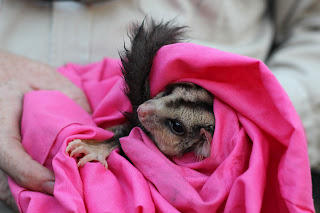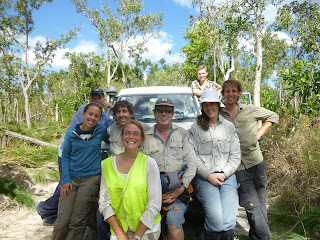I have started out my time in Oz volunteering with
Conservation Volunteers Australia (CVA).
During my second week, we worked with some folks at the Queensland Parks
and Wildlife Service in the Girringun National Park, which is located about halfway between
Cairns and
Townsville. The home range of the
endangered mahogany glider includes that area.
Gliders have a fold of skin that stretches between their front and back
legs allowing them to parachute from tree to tree. The mahogany glider is the second largest
glider species out of the six found in Australia. It is a nocturnal gliding possum (Aussie
possums are a bit cuter than American opossums), and this marsupial is fairly
elusive having “disappeared” for 100 years.
It is believed that the current population consists of approximately
1,300 gliders.
The mahogany glider is flexible in its diet, adjusting to
what is available (such as nectar or insects).
The bigger threat to the gliders is fragmentation of their range. The gliders prefer to stay up in the trees,
although they will come down to feed on the sweet nectar from the white flowers
of the grasstrees (see earlier post). This
species can glide distances up to 60 m, but the average glide is 30 m. Because the gliders want to stay up high, treeless
roads like the Bruce Highway
and right-of-ways challenge the movement of gliders. Some locations have installed special glider
poles to help them cross. The ideal
gliding habitat is a fairly open forest rather than dense rainforest
areas. In February 2011, Cyclone Yasi
heavily hit the range of the mahogany glider.
Forests can easily take a few years to fully recover from such natural
disasters. During this period, food
options are likely impacted; plants may place more energy into growing new
leaves rather than flowering. Also, the
loss of trees from the cyclone allows more sunlight to reach the forest
floor. New trees, especially the
seedlings of non-native pine trees from the nearby pine plantations, could
change the density of the forest. Even
though Yasi came through 1.5 years ago, it is still important to see how the
mahogany gliders are responding today.
We started each morning with our mahogany glider
survey. On Monday, we made a fresh batch
of bait – a mixture of honey, fruit juice, syrup, and a dash of vanilla. We put the new bait in the traps and set
them. Some of the traps also had
motion-triggered cameras. You can see
both the trap and camera in this photo:
For the next four mornings, we checked the 20 traps along a
grid, designed to be 100 m apart. The
QPWS folks also set another two traps where the odds of trapping a glider were
much higher. The grid we covered included
the sites used by someone’s 1997 Ph.D. research, so this area has been monitored
for awhile. Normally, they would expect
a 15% trap rate, but we saw none in our grid.
Fortunately for us, “Princess” was trapped in one of the extra two
traps. Here she is, looking as though
she took a bath in the sticky bait:
Cute, right? Princess
has been trapped before and chipped (not all trapped gliders are chipped). She looked good, and based on her swollen
pouch, she was caring for young back in her den. Mahogany gliders are monogamous, and both
parents care for the young, so the babies would be okay without her for a
day. She was trapped last December and
had young then, so she likely had two broads in one year. They typically have only one a year, so it is
a good sign. However, the QPWS rangers
didn’t know why we failed to trap any in our grid during this survey. Clearly, there are some factors in play. We left the cameras up for continued
monitoring.
Here’s a group shot of the crew over the week, after some
hard work maintaining the ideal gliding habitat. For those of you who know me, we are required
to wear pants and long sleeves.
Otherwise, I would be wearing shorts if I could.





No comments:
Post a Comment